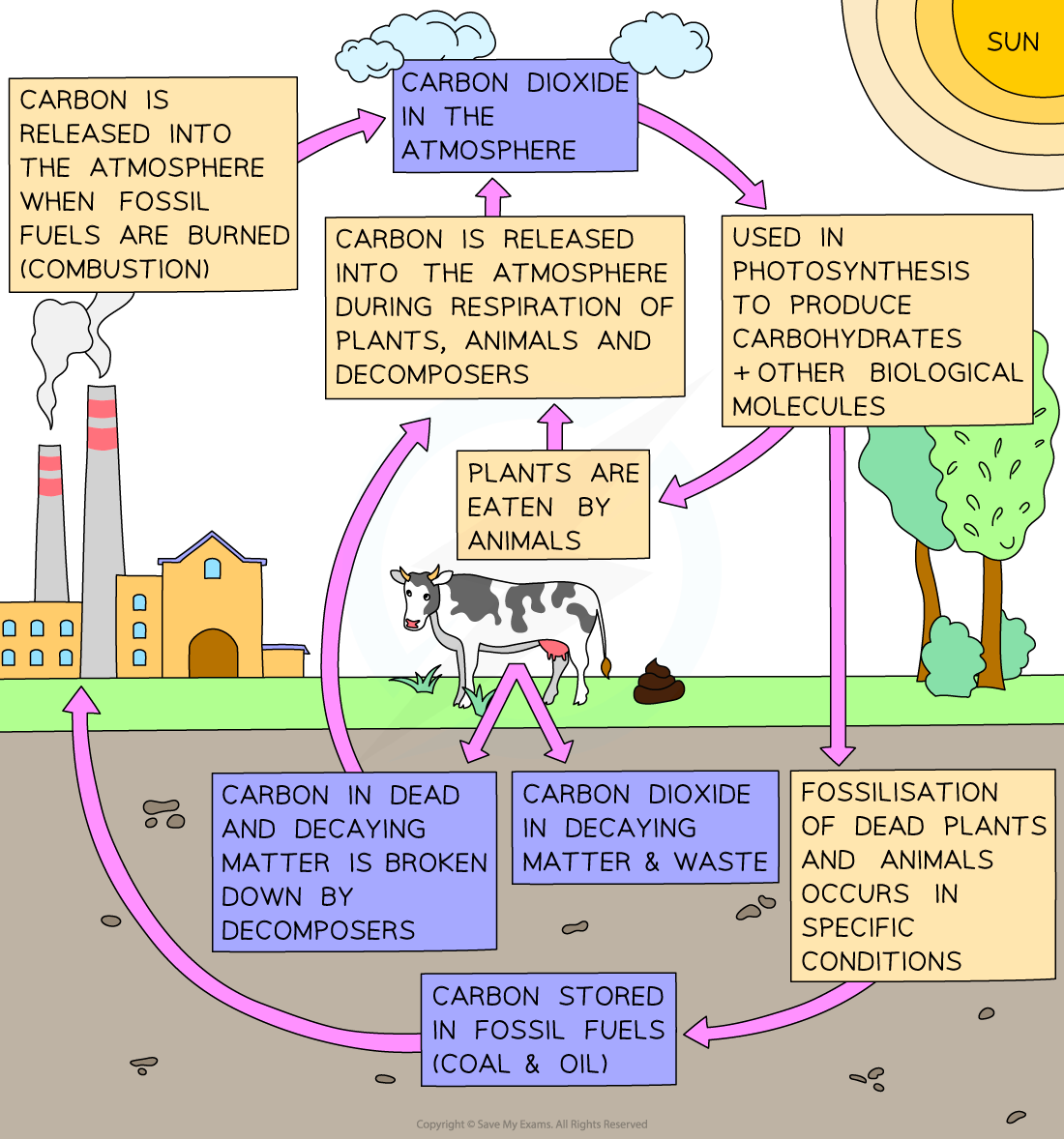The Carbon Cycle (Cambridge (CIE) AS Environmental Management) : Revision Note
The Carbon Cycle
Many different materials cycle through the abiotic and biotic components of an ecosystem
All materials in the living world are recycled to provide the building blocks for future organisms
Elements such as carbon are not limitless resources
There is a finite amount of each element on the planet
Elements need to be recycled in order to allow new organisms to be made and grow
Carbon is constantly being recycled around the biosphere so that the total amount of carbon in the biosphere is essentially constant
Carbon is transferred from one form to another by the various processes in the carbon cycle
The main processes of the carbon cycle include the following:
Photosynthesis
Respiration
Feeding
Decomposition
Fossilisation
Combustion

Photosynthesis
Producers such as plants and algae use the energy of sunlight to 'fix' carbon dioxide, turning its carbon into sugars and other organic molecules
This removes carbon from the atmosphere
Terrestrial plants use gaseous CO₂ directly from the air
Aquatic organisms use CO₂ dissolved in water
Just as much, if not more, CO₂ is fixed by ocean microorganisms, as by terrestrial plants
Respiration
All life forms respire, including producers and microorganisms
Respiration is the conversion of glucose and oxygen into carbon dioxide and water, releasing energy
Respiration puts carbon into the atmosphere in the form of CO₂
Feeding
Carbon is passed from producers to consumers during feeding
Carbon is also passed between consumers (e.g. from primary consumer to secondary consumer)
Biomass transfer (feeding) always includes the transfer of carbon, the main element in living tissues
Decomposition
Decomposition is the activity of microorganisms on dead matter and biological waste
Dead plants and animals are fed upon by detritivores and decayed by microorganisms such as bacteria and fungi
Decomposers use dead organisms and waste as a source of nutrition and so release CO₂ when they respire
This releases carbon back into the atmosphere
Fossilisation
If animals and plants die in conditions where decomposing microorganisms are not present, the carbon in their bodies can be converted, over millions of years and significant pressure, into fossil fuels such as peat and coal
Aquatic organisms that die also form sediments on the sea bed
These can go on to form other fossil fuels like oil and gas
Combustion
When fossil fuels are burned, the carbon locked within them combines with oxygen to form CO₂, which is released into the atmosphere
This process is known as combustion
Increased use of fossil fuels is contributing to an artificial increase in the carbon content of the atmosphere
CO₂ is being returned to the atmosphere faster than it can be absorbed by plants and aquatic producers
The concentration of CO₂ in the atmosphere is approximately double that of 800,000 years ago
Warmer temperatures also mean that less CO₂ can be dissolved in the oceans, so this also increases CO₂ concentrations in the atmosphere
Carbon Stores
Carbon is stored in short-term and long-term stores known as carbon stores (or carbon sinks)
A carbon store is a natural (or sometimes artificial) store that absorbs carbon through one of the carbon cycle processes (such as photosynthesis)
The main stores of carbon are located in, and transferred between the following:
Biosphere
Lithosphere
Pedosphere
Cryosphere
Atmosphere
Hydrosphere

Main Stores of the Carbon Cycle
Carbon Store | Forms of Carbon |
|---|---|
Biosphere | As organic molecules in living (and recently dead) organisms, including marine and aquatic life |
Lithosphere | The largest of the carbon stores - as sedimentary rocks containing carbon such as limestone (calcium carbonate), as fossil fuels, and as marine sediments from shells and marine skeletons |
Pedosphere | Soils store 300 billion tonnes of carbon as organic matter, soil organisms and the remains of dead plants & animals |
Cryosphere | Frozen ground (permafrost) of tundra and arctic regions contains plant material |
Atmosphere | Mainly as carbon dioxide CO2 and methane CH4 |
Hydrosphere | In the oceans as dissolved atmospheric CO2 and in calcium carbonate shells of marine organisms |
Examiner Tips and Tricks
Don’t be overwhelmed by the carbon cycle - it’s actually quite simple:
Carbon is taken out of the atmosphere by photosynthesis
It is passed on to animals and decomposers by feeding
It is returned to the atmosphere by respiration; in plants, in animals and in decomposing microorganisms
In addition, it is returned by combustion of fossil fuels
Make sure you are able to identify what each arrow represents in any diagram of the carbon cycle.

You've read 0 of your 5 free revision notes this week
Sign up now. It’s free!
Did this page help you?

